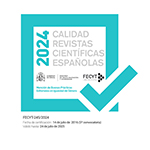The Didactic Sequence: An Instrument for Writing Texts in Childhood Education
Abstract
There are several works which show concern regarding teaching written language during the early school years. This issue has been the subject of debate for decades. Although for some time the focus of the teaching of initial writing focused on the use of different methods (synthetic or analytical mainly), from some decades on, it lies in the socio-cultural or socio-constructivist approaches. It is currently known that one of the key factors when learning writing skills is arranging the teaching-learning process on a functional basis. The social environment and the communicative situations are, therefore, the foundations in initial literacy. This work aims at contributing to the early teaching-learning process of texts through specific mediations. In this respect, this paper is intended to examine the design of a didactic sequence and analyse the results obtained from its implementation. As a means of research, a didactic sequence has been designed and implemented in the classroom. A total of 25 children belonging to the third grade of Childhood Education aged between four and five have participated in the study. The group is integrated by boys and girls not only from Valencia -where the research was carried out-but also from other geographical areas such as Morocco, Syria, Romania and Colombia. An analysis of the students’ written productions was carried out after the implementation. Results show that the didactic sequences focused on writing are effective tools that can help children write complex texts.
Downloads
Article download
License
In order to support the global exchange of knowledge, the journal Didáctica. Lengua y Literatura is allowing unrestricted access to its content as from its publication in this electronic edition, and as such it is an open-access journal. The originals published in this journal are the property of the Complutense University of Madrid and any reproduction thereof in full or in part must cite the source. All content is distributed under a Creative Commons Attribution 4.0 use and distribution licence (CC BY 4.0). This circumstance must be expressly stated in these terms where necessary. You can view the summary and the complete legal text of the licence.










